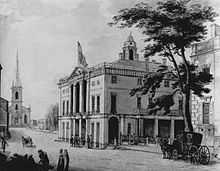|
18th New York State Legislature
The 18th New York State Legislature, consisting of the New York State Senate and the New York State Assembly, met from January 6 to April 9, 1795, during the eighteenth year of George Clinton's governorship, first in Poughkeepsie, then in New York City. BackgroundUnder the provisions of the New York Constitution of 1777, the state senators were elected on general tickets in the senatorial districts, and were then divided into four classes. Six senators each drew lots for a term of 1, 2, 3 or 4 years and, beginning at the election in April 1778, every year six Senate seats came up for election to a four-year term. Assemblymen were elected countywide on general tickets to a one-year term, the whole assembly being renewed annually. In March 1786, the legislature enacted that future legislatures meet on the first Tuesday of January of each year unless called earlier by the governor. No general meeting place was determined, leaving it to each Legislature to name the place where to reconvene, and if no place could be agreed upon, the legislature should meet again where it adjourned. On February 7, 1791, the legislature re-apportioned the Senate and Assembly districts, according to the figures of the 1790 United States census. At this time the politicians were divided into two opposing political parties: the Federalists and the Democratic-Republicans.[1] ElectionsThe State election was held from April 29 to May 1, 1794. Senators Matthew Clarkson (Southern D.), John Williams (Eastern D.), John Frey and Stephen Van Rensselaer (both Western D.) were re-elected. Assemblymen Richard Hatfield (Southern D.) and John D. Coe (Middle D.) were also elected to the Senate. Sessions The legislature met first in Poughkeepsie on January 6; and adjourned on January 14, 1795. The legislature met again at Federal Hall in New York City on January 20; and adjourned on April 9. William North was elected Speaker with 33 votes to 28 for James Watson, the Speaker of the previous Assembly, both were Federalists. The average vote for the members of the Council of Appointment was 36 to 29, showing a Federalist majority of 7.[2] On January 27, the Legislature re-elected Federalist Rufus King to the U.S. Senate. State SenateDistricts
Note: There are now 62 counties in the State of New York. The counties which are not mentioned in this list had not yet been established, or sufficiently organized, the area being included in one or more of the abovementioned counties. MembersThe asterisk (*) denotes members of the previous Legislature who continued in office as members of this Legislature. Richard Hatfield and John D. Coe changed from the Assembly to the Senate.
Employees
State AssemblyDistricts
Note: There are now 62 counties in the State of New York. The counties which are not mentioned in this list had not yet been established, or sufficiently organized, the area being included in one or more of the abovementioned counties. AssemblymenThe asterisk (*) denotes members of the previous Legislature who continued as members of this Legislature. David Pye changed from the Senate to the Assembly. Employees
Notes
Sources
|
|||||||||||||||||||||||||||||||||||||||||||||||||||||||||||||||||||||||||||||||||||||||||||||||||||||||||||||||||||||||||||||||||||||||||||||||||||
